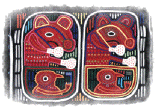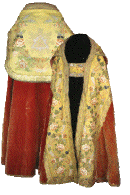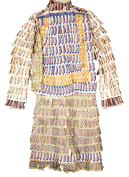
Click on these items from the collection for larger views and explanations.





|
 n a climate-controlled room on campus, tucked away between layers of acid-free tissue, lies an African tunic made of tiny overlapping pieces of hammered gold. Worn by a bride in Tunisia over a century ago, the piece is so rare that even an experienced appraiser could not identify its origins, mistaking it for a barber's ornamental robe. This rare tunic is just one example of labor-intensive garments that are rapidly disappearing. Techniques such as embroidery, the use of embellishments, beading and sequins are being abandoned in favor of simpler, factory-produced clothing of western cultures.
n a climate-controlled room on campus, tucked away between layers of acid-free tissue, lies an African tunic made of tiny overlapping pieces of hammered gold. Worn by a bride in Tunisia over a century ago, the piece is so rare that even an experienced appraiser could not identify its origins, mistaking it for a barber's ornamental robe. This rare tunic is just one example of labor-intensive garments that are rapidly disappearing. Techniques such as embroidery, the use of embellishments, beading and sequins are being abandoned in favor of simpler, factory-produced clothing of western cultures.
Preservation of these endangered textiles is one of the goals of the UC Davis design program's collection of artifacts from around the world, said JoAnn Stabb, chair of the design program. The two-fold purpose of the collection--which includes furniture, toys, basketry, costume items, laces and many ethnographic textiles--is to protect these real-life representatives of disappearing art and to provide students with an educational supplement to the traditional slides shown in design courses.
In studio classes, the fabric and clothing provide examples for students learning design and construction methods, as well as techniques like the cross-stitch or a mirror-work buttonhole stitch. Students in other classes often study the history behind a costume or the cultural context of individual pieces.
The collection is diverse in its representation of geography, eras and cultures. It features over 8,000 items, dating from the 1500s to the present. Pieces range from ecclesiastical vestments from 18th-century Europe to ceremonial banners from 20th-century Japan and molas, or appliquéd panels, from 20th-century Panama.
With only a tiny budget for purchases, the collection has been built almost solely from donations by the community and faculty. Jeffrey Ruda, director of the art history program, recently donated several valuable items from the European Renaissance. "I think that, under the circumstances, we have many remarkable pieces," said Gayle BonDurant, the manager of the collection.
The preservation of the items becomes more important as the creators of these vanishing textiles assimilate into late 20th-century culture.
"Increasingly, rare pieces by the world's indigenous peoples are cut into fragments to be exported on a vest or a western backpack," said Stabb. "What we are trying to do is save full, entire costumes. As these cultures are being uprooted, they're abandoning all these techniques. Globalization--soon we'll all be wearing identical outfits of Nikes and T-shirts."
-- Collette Boothe
|
